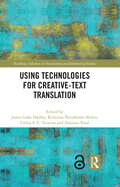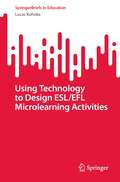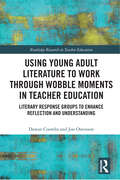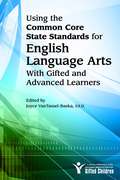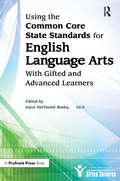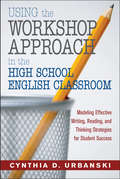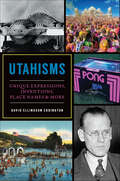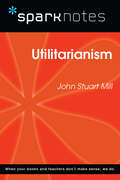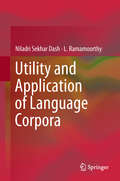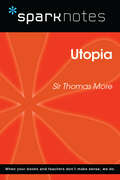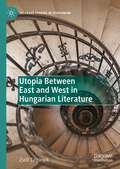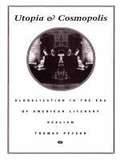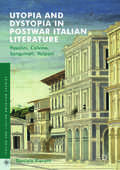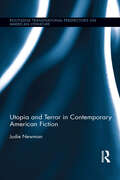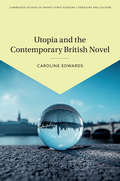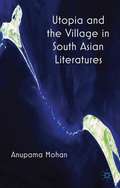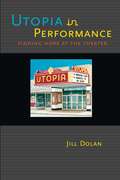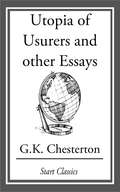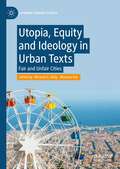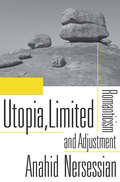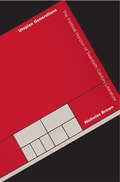- Table View
- List View
Using Technologies for Creative-Text Translation (Routledge Advances in Translation and Interpreting Studies)
by James Luke Hadley Kristiina Taivalkoski-Shilov Antonio Toral Teixeira, Carlos S. C.This collection reflects on the state of the art of research into the use of translation technologies in the translation of creative texts, encompassing literary texts but also extending beyond to cultural texts, and charts their development and paths for further research. Bringing together perspectives from scholars across the discipline, the book considers recent trends and developments in technology that have spurred growing interest in the use of computer-aided translation (CAT) and machine translation (MT) tools in literary translation. Chapters examine the relationships between translators and these tools–the extent to which they already use such technologies, the challenges they face, and prevailing attitudes towards these tools–as well as the ethical implications of such technologies in translation practice. The volume gives special focus to drawing on examples with and beyond traditional literary genres to look to these technologies’ use in working with the larger group of creative texts, setting the stage for many future research opportunities. The book will be of particular interest to students and scholars in translation studies, especially those with an interest in literary translation, translation technology, translation practice, and translation ethics.
Using Technology to Design ESL/EFL Microlearning Activities (SpringerBriefs in Education)
by Lucas KohnkeThis book provides strategies, tools, and best practices for incorporating microlearning in English language teaching. It aims to help teachers create and deliver microlearning mechanisms that are optimized for mobile learning. This book also draws on relevant literature and the author’s first-hand experience designing microlearning activities for English learners. It covers important aspects of microlearning, including artificial intelligence, virtual reality, augmented reality, and mixed modalities. It is an important starting point for teachers, academics, and researchers interested in the principles and practice of microlearning in English language teaching. English language teachers in formal and informal education environments find this work thought-provoking, instructive, and informative and benefit from exploring the possibilities of microlearning to motivate and engage learners and maximize the number and quality of their learning experiences.
Using Words and Things: Language and Philosophy of Technology (Routledge Studies in Contemporary Philosophy)
by Mark CoeckelberghThis book offers a systematic framework for thinking about the relationship between language and technology and an argument for interweaving thinking about technology with thinking about language. The main claim of philosophy of technology—that technologies are not mere tools and artefacts not mere things, but crucially and significantly shape what we perceive, do, and are—is re-thought in a way that accounts for the role of language in human technological experiences and practices. Engaging with work by Wittgenstein, Heidegger, McLuhan, Searle, Ihde, Latour, Ricoeur, and many others, the author critically responds to, and constructs a synthesis of, three "extreme", idealtype, untenable positions: (1) only humans speak and neither language nor technologies speak, (2) only language speaks and neither humans nor technologies speak, and (3) only technology speaks and neither humans nor language speak. The construction of this synthesis goes hand in hand with a narrative about subjects and objects that become entangled and constitute one another. Using Words and Things thus draws in central discussions from other subdisciplines in philosophy, such as philosophy of language, epistemology, and metaphysics, to offer an original theory of the relationship between language and (philosophy of) technology centered on use, performance, and narrative, and taking a transcendental turn.
Using Young Adult Literature to Work through Wobble Moments in Teacher Education: Literary Response Groups to Enhance Reflection and Understanding (Routledge Research in Teacher Education)
by Dawan Coombs Jon OstensonThis volume offers a novel approach to exploring how literary response groups can be used as part of teacher education programs to help preservice teachers navigate "wobble" moments. Focusing uniquely on the potential of young adult literature (YAL), the text draws on the first-hand experiences of teacher candidates and uses a range of well-known books to demonstrate how narrative-based inquiry and analysis of fictional depictions of teaching and learning can support reflection on a range of common challenges. The volume presents how YAL literary response groups are shown to enhance participants’ ability to reflect on practice, build resilience, and develop deeper understanding of pedagogical principles by offering a shared dialogical space. These insights ultimately contribute to teacher education program improvement by enhancing teacher candidates’ understanding of pedagogy. This text will benefit researchers, doctoral students, and academics in the fields of teaching, teacher mentoring, and teacher education more specifically. Those interested in literature studies and young adult literature (YAL) more broadly will also benefit from this volume.
Using a Net
by Jessica QuiltyThe fun and excitement of English and Language Arts learning continues in Grade 2 of Reading Street. This comprehensive and dynamic curriculum for homeschooling is geared toward young children who have some foundational English and Language Arts knowledge and are ready to strengthen their skills. Comprised of engaging activities, challenging content and weekly quizzes, Reading Street: Grade 2 is the next step in your child's path toward becoming a lifelong learner and reader. As with all Reading Street products, the Grade 2 system is formatted to help students meet certain age-appropriate goals. After completing this English and Language Arts homeschool program, your child should be able to: Read and comprehend two-syllable words. Identify common prefixes (such as pre-, un-, or re-) and suffixes (such as -able, -ad and -er). Correct mistakes made when reading out loud. Read books with two or more chapters. Understand the structure of stores (i. e. beginning, middle and end). Start selecting reading materials based on his/her own interests. Identify the "who," "what," "when," "where," "why" and "how" of the text. While the goals of second Grade English and Language Arts are numerous, Reading Street will help you craft engrossing lessons. Your child will garner important English and Language Arts skills while completing a workbook, reading stories and poems, and taking assessments. Planning these lessons will be easier than ever, as all Reading Street systems are broken down into weekly Big Ideas. All the work your child does on a given week is formulated around that single concept for an organized and challenging curriculum. With six easy-to-follow units, Reading Street: Grade 2 is the perfect tool for homeschooling parents. Your child will enjoy the reading selections and activities, and you'll love to see your student growing into a knowledgeable individual. We're confident that this product is the right one for you. For more information on the specific materials found in Grade 2 of Reading Street, check out the Features and Benefits page.
Using the Common Core State Standards for English Language Arts With Gifted and Advanced Learners
by Joyce Vantassel-BaskaUsing the Common Core State Standards in English Language Arts With Gifted and Advanced Learners provides teachers and administrators examples and strategies to implement the new Common Core State Standards (CCSS) with advanced learners at all stages of development in K-12 schools. The book describes--and demonstrates with specific examples from the CCSS--what effective differentiated activities in English language arts look like for top learners. It shares how educators can provide both rigor and relevance within the new standards as they translate them into meaningful experiences for gifted and advanced learners.
Using the Common Core State Standards for English Language Arts With Gifted and Advanced Learners
by National Assoc For Gifted ChildrenUsing the Common Core State Standards for English Language Arts With Gifted and Advanced Learners provides teachers and administrators examples and strategies to implement the new Common Core State Standards (CCSS) with advanced learners at all stages of development in K-12 schools. The book describes—and demonstrates with specific examples from the CCSS—what effective differentiated activities in English language arts look like for top learners. It shares how educators can provide both rigor and relevance within the new standards as they translate them into meaningful experiences for gifted and advanced learners.
Using the Workshop Approach in the High School English Classroom: Modeling Effective Writing, Reading, and Thinking Strategies for Student Success
by Cynthia D. UrbanskiTake a peek into an effective workshop-based classroom and discover how you can enhance adolescents' technical and creative abilities in reading, writing, and thinking.
Utahisms: Unique Expressions, Inventions, Place Names & More
by David Ellingson EddingtonUtahisms: Unique Expressions, Inventions, Place Names and more ranges from the characteristic to the bizarreThe Beehive State's iconic vistas are singular and distinctive. So too are its colloquialisms, peculiar place names and landmark firsts. Confusion from local dialect ultimately thwarted a would be robber in Salt Lake City. The proper pronunciation of Tooele might surprise visitors, while residents still debate its origins. And, phrases once thought to be solely Utahn often prove otherwise. The world's first department store was born out of xenophobia and religious persecution in 1869. Martha Hughes Cannon followed through on Brigham Young's encouraging women to become physicians. She later became the first female state senator in the United States, defeating her own husband. Examining everything from phonetics to history, BYU Linguistics Professor David Eddington reveals the roots of what is truly, uniquely Utah.
Utilitarianism (SparkNotes Philosophy Guide)
by SparkNotesUtilitarianism (SparkNotes Philosophy Guide) Making the reading experience fun! SparkNotes Philosophy Guides are one-stop guides to the great works of philosophy–masterpieces that stand at the foundations of Western thought. Inside each Philosophy Guide you&’ll find insightful overviews of great philosophical works of the Western world.
Utility and Application of Language Corpora
by Niladri Sekhar Dash L. RamamoorthyThis book discusses some of the basic issues relating to corpus generation and the methods normally used to generate a corpus. Since corpus-related research goes beyond corpus generation, the book also addresses other major topics connected with the use and application of language corpora, namely, corpus readiness in the context of corpus sanitation and pre-editing of corpus texts; the application of statistical methods; and various text processing techniques. Importantly, it explores how corpora can be used as a primary or secondary resource in English language teaching, in creating dictionaries, in word sense disambiguation, in various language technologies, and in other branches of linguistics. Lastly, the book sheds light on the status quo of corpus generation in Indian languages and identifies current and future needs.Discussing various technical issues in the field in a lucid manner, providing extensive new diagrams and charts for easy comprehension, and using simplified English, the book is an ideal resource for non-native English readers. Written by academics with many years of experience teaching and researching corpus linguistics, its focus on Indian languages and on English corpora makes it applicable to graduate and postgraduate students of applied linguistics, computational linguistics and language processing in South Asia and across countries where English is spoken as a first or second language.
Utopia (SparkNotes Philosophy Guide)
by SparkNotesUtopia (SparkNotes Philosophy Guide) Making the reading experience fun! SparkNotes Philosophy Guides are one-stop guides to the great works of philosophy–masterpieces that stand at the foundations of Western thought. Inside each Philosophy Guide you&’ll find insightful overviews of great philosophical works of the Western world.
Utopia Between East and West in Hungarian Literature (Palgrave Studies in Utopianism)
by Zsolt CzigányikThis book focuses on the most important utopian and dystopian literary texts in nineteenth and twentieth-century Hungarian literature, and therefore widens the scope of the traditionally Anglophone canon. Utopian studies is becoming increasingly interdisciplinary, and this research integrates literary hermeneutics with ideas and methods from political science and the history of ideas. In doing so, it argues that Hungarian utopianism was influenced by the region’s (and Hungarian culture’s) position of permanent liminality between Western and Eastern European patterns of power structures, social and political order. After a thorough methodological introduction, some early modern texts written in Hungary are discussed, while the detailed analyses focus on nineteenth-century texts, written by Bessenyei, Madách, and Jókai, whereas the twentieth century is represented by Karinthy, Babits and Szathmári. In the interpretations the results of contemporary scholarship is applied, particularly the works of Lyman Tower Sargent, Gregory Claeys and Fátima Vieira.
Utopia and Cosmopolis: Globalization in the Era of American Literary Realism
by Thomas PeyserWhen did Americans first believe they were at the center of a truly global culture? How did they envision that culture and how much do recent attitudes toward globalization owe to their often utopian dreams? In Utopia and Cosmopolis Thomas Peyser asks these and other questions, offers a reevaluation of American literature and culture at the dawn of the twentieth century, and provides a new context for understanding contemporary debates about America's relation to the rest of the world. Applying current theoretical work on globalization to the writing of authors as diverse as Edward Bellamy, Charlotte Perkins Gilman, William Dean Howells, and Henry James, Peyser reveals the ways in which turn-of-the-century American writers struggled to understand the future in a newly emerging global community. Because the pressures of globalization at once fostered the formation of an American national culture and made national culture less viable as a source of identity, authors grappled to find a form of fiction that could accommodate the contradictions of their condition. Utopia and Cosmopolis unites utopian and realist narratives in subtle, startling ways through an examination of these writers' aspirations and anxieties. Whether exploring the first vision of a world brought together by the power of consumer culture, or showing how different cultures could be managed when reconceived as specimens in a museum, this book steadily extends the horizons within which late nineteenth- and early twentieth-century American literature and culture can be understood. Ranging widely over history, politics, philosophy, and literature, Utopia and Cosmopolis is an important contribution to debates about utopian thought, globalization, and American literature.
Utopia and Dystopia in Postwar Italian Literature
by Daniele FiorettiThis book is about the presence of utopian and dystopian elements in the Italian literary landscape. It focuses on four authors that are representatives of the various positions in the Italian cultural debate: Pasolini, Calvino, Sanguineti, and Volponi. What did concepts like utopia and dystopia mean for these authors? Is it possible to separate utopia from dystopia? What is the role of science fiction in this debate? This book answers these questions, proposing an original interpretation of utopia and of the social role of literature. The book also takes into consideration four of the most influential literary journals in Italy: Officina, il menab#65533;, il verri, and Nuovi Argomenti, that played a central role in the cultural and political debate on utopia in Italy.
Utopia and Terror in Contemporary American Fiction (Routledge Transnational Perspectives on American Literature #21)
by Judie NewmanThis book examines the quest for/failure of Utopia across a range of contemporary American/transnational fictions in relation to terror and globalization through authors such as Susan Choi, André Dubus, Dalia Sofer, and John Updike. While recent critical thinkers have reengaged with Utopia, the possibility of terror — whether state or non-state, external or homegrown — shadows Utopian imaginings. Terror and Utopia are linked in fiction through the exploration of the commodification of affect, a phenomenon of a globalized world in which feelings are managed, homogenized across cultures, exaggerated, or expunged according to a dominant model. Narrative approaches to the terrorist offer a means to investigate the ways in which fiction can resist commodification of affect, and maintain a reasoned but imaginative vision of possibilities for human community. Newman explores topics such as the first American bestseller with a Muslim protagonist, the links between writer and terrorist, the work of Iranian-Jewish Americans, and the relation of race and religion to Utopian thought.
Utopia and the Contemporary British Novel (Cambridge Studies in Twenty-First-Century Literature and Culture #3)
by Caroline EdwardsThis book examines the experience of time functions in a specific set of British novels to reveal the persistence of the utopian imagination in the twenty-first century. Through close textual analysis, Edwards develops a new strategy of reading such anticipatory 'fictions of the not yet', including novels by Hari Kunzru, Maggie Gee, David Mitchell, Ali Smith, Jim Crace, Joanna Kavenna, Grace McCleen, Jon McGregor, and Claire Fuller. Read in the context of the philosophical category of non-contemporaneity, these novels reveal a significant new direction in twenty-first-century fiction. Their formal inventiveness and suggestively non-mimetic encounters with otherwise realist narrative representations of contemporary experience open up a realm of utopian possibility that shines through in moments of temporal alterity: glimpses of the future, redeemed strands of past hopes, and alternative social worlds already alive in the present.
Utopia and the Village in South Asian Literatures
by Anupama MohanShifting the postcolonial focus away from the city and towards the village, this book examines the rural as a trope in twentieth-century South Asian literatures to propose a new literary history based on notions of utopia, dystopia, and heterotopia and how these ideas have circulated in the literary and the cultural imaginaries of the subcontinent.
Utopia in Performance
by Jill DolanLive performance can provide people with inspiration for an improved world, Dolan argues, one that seems to be slipping further away since 9/11. As examples, she analyzes autobiographical performances by feminists Holly Hughes, Peggy Shaw, and Deb Margolin; multiple- character monologues by Lily Tomlin, Danny Hoch, and Anna Deavere Smith; the political suggestions of Russell Simmons Def Poetry Jam on Broadway and The Laramie Project; and radical humanism in Ann Carlson's Blanket, Mary Zimmerman's Metamorphoses, and Deborah Warner and Fiona Shaw's Medea. Annotation ©2006 Book News, Inc. , Portland, OR (booknews. com)
Utopia of Usurers and other Essays
by G. K. ChestertonWhat is it that angers Chesterton and fills him with grim forebodings for the future of his island? Many things and, especially, many persons. But chiefly the capitalists, the upper middle class, the usurers, or however they be termed, and the fear of the servile state, the state in which art and literature and science and efficiency and morality and everything else that has value in the eyes of mortal man become the humble servants of the money-changers, in short, the "utopia of usurers." --The Dial, 1918.
Utopia, Equity and Ideology in Urban Texts: Fair and Unfair Cities (Literary Urban Studies)
by Mariano Paz Michael G. KellyUtopia, Equity and Ideology in Urban Texts: Fair and Unfair Cities explores the complex interrelations of three key critical topics across a diverse range of urban writing. Interrogating the links and tensions between aesthetic and political priorities in the representation and imagining of urban life, the volume engages with work from a wide variety of linguistic and cultural origins and across a range of textual practices having the urban phenomenon as a common framing concern. Individual contributions discussing genre and literary fiction, poetic writing, documentary and essayistic texts, planning manifestos and municipal communications materials serve to demonstrate that the nuanced treatments of urban experience and potential which may be gleaned from across this textual spectrum act as a pragmatic corrective to purely conceptual approaches. As such, the volume consolidates the emerging dialogue between the fields of utopian studies and literary urban studies, understanding these as complementary approaches to the reading of the city and its textual prolongations.
Utopia, Limited
by Anahid NersessianWhat is utopia if not a perfect impossible world? Anahid Nersessian reveals the basic misunderstanding of that ideal. Applying the lessons of art to the rigors of life on an imperiled planet, she enlists the Romantics to redefine utopia as an investment in limitation--not a perfect world but one where we get less than we hoped but more than we had.
Utopia, Limited: Romanticism and Adjustment
by Anahid NersessianWhat is utopia if not a perfect world, impossible to achieve? Anahid Nersessian reveals a basic misunderstanding lurking behind that ideal. In Utopia, Limited she enlists William Blake, William Wordsworth, John Keats, and others to redefine utopianism as a positive investment in limitations. Linking the ecological imperative to live within our means to the aesthetic philosophy of the Romantic period, Nersessian’s theory of utopia promises not an unconditionally perfect world but a better world where we get less than we hoped, but more than we had. For the Romantic writers, the project of utopia and the project of art were identical. Blake believed that without limits, a work of art would be no more than a set of squiggles on a page, or a string of nonsensical letters and sounds. And without boundaries, utopia is merely an extension of the world as we know it, but blighted by a hunger for having it all. Nersessian proposes that we think about utopia as the Romantics thought about aesthetics―as a way to bind and thereby emancipate human political potential within a finite space. Grounded in an intellectual tradition that begins with Immanuel Kant and includes Theodor Adorno and Northrop Frye, Utopia, Limited lays out a program of “adjustment” that applies the lessons of art to the rigors of life on an imperiled planet. It is a sincere response to environmental devastation, offering us a road map through a restricted future.
Utopian Fantasy: A Study of English Utopian Fiction since the End of the Nineteenth Century (Routledge Library Editions: Utopias)
by Richard GerberThis book, originally published in 1955 and reissued in 1973, is a study of the flourishing of an ancient literary form which had only recently been recognized and systematically studied as a proper genre – utopian fiction. Beginning with the imaginary journeys of writers like H. G. Wells at the end of the nineteenth century, Professor Gerber traces the evolving themes and forms of the genre through their culmination in the sophisticated nightmares of Aldous Huxley and George Orwell. It is a two-fold transformation: On the one hand, the optimism of social reformers whose visions of the future were nurtured by the theories of Darwin and the triumph of science and industry gradually gives way to the pessimism of moral philosophers alarmed at the power science and technology have put at the disposal of totalitarian rulers. On the other hand, the earlier writers’ dependence on framing and distancing devices for their stories and heavy emphasis on technical details give way to the subtlety of complex psychological novels whose artistry makes the reader a citizen of the tragic worlds depicted.
Utopian Generations: The Political Horizon of Twentieth-Century Literature (Translation/Transnation #11)
by Nicholas BrownUtopian Generations develops a powerful interpretive matrix for understanding world literature--one that renders modernism and postcolonial African literature comprehensible in a single framework, within which neither will ever look the same. African literature has commonly been seen as representationally naïve vis-à-vis modernism, and canonical modernism as reactionary vis-à-vis postcolonial literature. What brings these two bodies of work together, argues Nicholas Brown, is their disposition toward Utopia or "the horizon of a radical reconfiguration of social relations.? Grounded in a profound rethinking of the Hegelian Marxist tradition, this fluently written book takes as its point of departure the partial displacement during the twentieth century of capitalism's "internal limit" (classically conceived as the conflict between labor and capital) onto a geographic division of labor and wealth. Dispensing with whole genres of commonplace contemporary pieties, Brown examines works from both sides of this division to create a dialectical mapping of different modes of Utopian aesthetic practice. The theory of world literature developed in the introduction grounds the subtle and powerful readings at the heart of the book--focusing on works by James Joyce, Cheikh Hamidou Kane, Ford Madox Ford, Chinua Achebe, Wyndham Lewis, Ngugi wa Thiong'o, and Pepetela. A final chapter, arguing that this literary dialectic has reached a point of exhaustion, suggests that a radically reconceived notion of musical practice may be required to discern the Utopian desire immanent in the products of contemporary culture.
